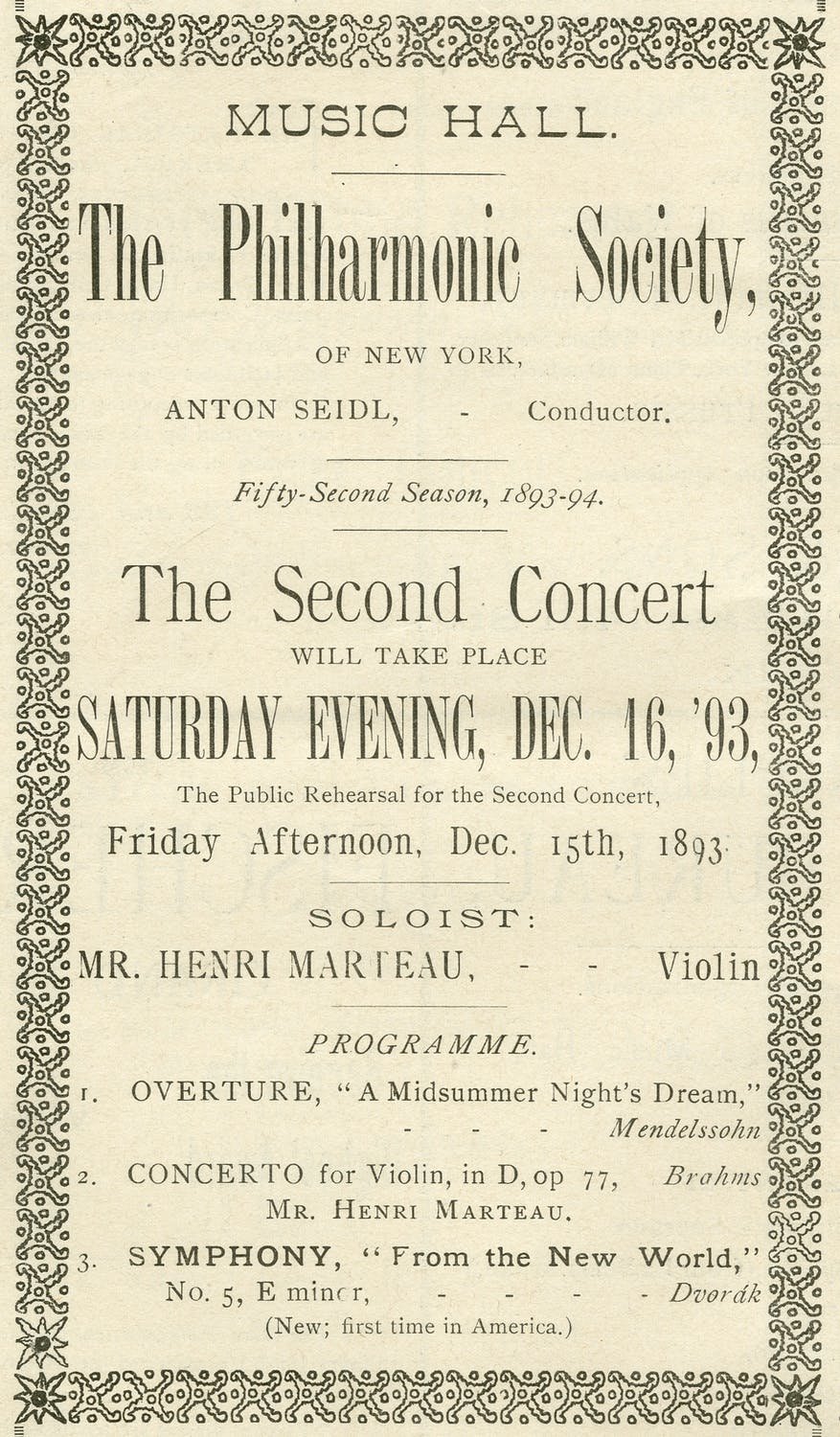Celebrating the "New World" Symphony
Today we celebrate the 130th anniversary of composer Antonín Dvořák’s world-famous Symphony No. 9 in E minor, “From the New World,” which premiered at performances in New York City on December 15 and 16, 1893. We are pleased to invite you to listen to a recording of the New York Philharmonic, the storied orchestra that premiered the symphony at Carnegie Hall, and to explore the history of this great work on the day of its hugely successful introduction in Gilded Age New York.
For this special occasion Professor Michael Beckerman, Carroll and Milton Petrie Professor of Music at New York University , reflects on Dvořák’s masterwork:
“This year marks the 130th anniversary of one of the great concert works, Dvořák’s symphony, ‘From the New World.’ Composed at least in part as an attempt to show American composers and audiences what an ‘American music’ could sound like, this epic work synthesizes the international symphonic tradition through the lens of the composer’s orientation as a Bohemian outsider who had worked his way up to being acknowledged as one of Europe’s leading composers. But it also marked the attempt to integrate African and Native American music and Longfellow’s Song of Hiawatha into that tradition.”
About the “New World” Symphony
Premiere dates: December 15 and 16, 1893
A historic event in New York musical life, the premiere of Antonín Dvořák’s Symphony No. 9 in E minor, ”From the New World,” was the first major symphony premiered by the New York Philharmonic, then called the Philharmonic Society, and it took place at the new grand Music Hall on 57th Street, later named Carnegie Hall.
The gala evening performance on December 16 was preceded by an afternoon performance on December 15, assuring access to a broad public. Both were conducted by the eminent Anton Seidl. Gilded Age New Yorkers attending the evening performance were thrilled – cheering after the symphonic movements and forcing the somewhat reserved composer to take bows from his box. Culminating the first year of Dvořák’s influential American residency from 1892 to 1895, the work has become one of the most popular symphonies heard in concert halls, on air, and in digital media today.
As Director of the National Conservatory of Music of America in New York City – at the invitation of its visionary founder Jeannette Meyer Thurber – the celebrity Czech composer absorbed American sights and sounds and was deeply influenced by both African American and Native American melodic traditions. His masterwork, composed in New York City, conveyed his impressions of the New World at the same time as it reflected both his Bohemian origin and European compositional approaches.
Newspapers wrote extensively of Dvořák’s new work, greeting the effort to pave the way to an American school of composition with widespread interest and enthusiasm - as well as some skepticism and controversy. For 130 years the work has excited, attracted, and stimulated music-loving audiences, building a legacy through Dvořák’s students at the Conservatory as well. May the unprecedented reception of this singular work and its great composer continue to grow and inspire for many years to come.
A “calling card” for the New York Philharmonic, the “New World” Symphony, has been performed in many corners of the world, not least of which was East Pyongyang Grand Theatre in North Korea, where it was presented in 2008 under the baton of Lorin Maazel. Listen to it here.
The momentous event of December 15/16, 1893 may be further explored through Carnegie Hall archives.
Learn about Dvořák’s American residency from 1892 to 1895 in “Dvořák in America.”
Recommended reading: Michael Beckerman, New Worlds of Dvořák (W. W. Norton, 2003) and Dvořák and His World (Princeton University Press, 1993), and Maurice Peress, Dvořák to Duke Ellington (Oxford University Press, 2008).
The Dvořák American Heritage Association has proudly presented the “New World” symphony in our historic home, the Bohemian National Hall (1896) in New York City, and our members, through books, performances, lectures, seminars, and other projects, continue to call attention to the work and use it as the focus of intense discussion on many issues. DAHA also welcomes visitors to The Dvořák Room, our special exhibition and study space, and on walking tours exploring Dvořák’s New York.
The Dvořák American Heritage Association (DAHA) commemorates, celebrates, and continues to explore composer Antonín Dvořák's extraordinary musical contributions, with a special emphasis on his “American” years, from 1892 to 1895. From its home in the beautifully restored Bohemian National Hall (1896) in New York City, DAHA offers concerts, lectures, and educational programs. At the heart of these activities is the Dvořák Room, a newly created exhibition and study space with adjacent performance venues, that will inspire present and future generations by preserving the composer's American legacy.

